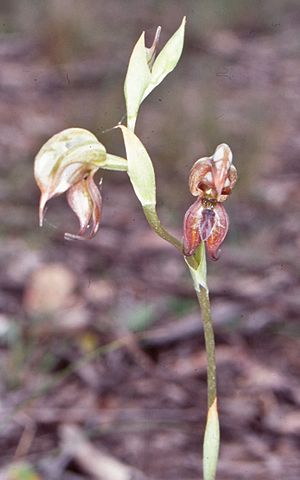Bungonia rustyhood facts for kids
Quick facts for kids Bungonia rustyhood |
|
|---|---|
 |
|
| Scientific classification | |
| Genus: |
Pterostylis
|
| Species: |
calceolus
|
| Synonyms | |
|
Oligochaetochilus calceolus (M.A.Clem.) Szlach. |
|
The Bungonia rustyhood (scientific name: Pterostylis calceolus) is a special type of plant. It belongs to the orchid family, which is known for its beautiful and unique flowers. This orchid is found only in New South Wales, Australia, making it an endemic species. It grows near a place called Bungonia.
This orchid has a group of leaves that grow in a circle, like a rose, called a rosette. It produces between two and seven reddish-brown flowers. These flowers have clear, see-through parts that look like "windows." They also have a thick, brown, insect-like part called a labellum.
Contents
What the Bungonia Rustyhood Looks Like
The Bungonia rustyhood is a plant that grows from an underground part called a tuber. It's a perennial plant, meaning it lives for more than two years. It's also a deciduous herb, which means its leaves fall off during certain seasons.
Leaves and Stems
This orchid has a rosette of four to six egg-shaped leaves. Each leaf is about 1.5 to 3 centimeters (about 0.6 to 1.2 inches) long. They are also about 0.8 to 1.2 centimeters (about 0.3 to 0.5 inches) wide.
The flowers grow on a tall stem called a flowering spike. This spike can be between 10 to 20 centimeters (about 4 to 8 inches) tall. It has two to four leaves wrapped around it.
Flowers
The Bungonia rustyhood produces between two and seven reddish-brown flowers. These flowers have clear, see-through sections. Each flower is about 1.9 to 2.2 centimeters (about 0.7 to 0.9 inches) long. They are also about 0.5 to 0.7 centimeters (about 0.2 to 0.3 inches) wide.
The top part of the flower, called the dorsal sepal, and the petals join together. They form a hood, or "galea," over the central part of the flower called the column. The dorsal sepal has a thin, thread-like tip that points downwards. This tip is about 0.4 to 0.5 centimeters (about 0.16 to 0.2 inches) long.
The two side parts of the flower, called the lateral sepals, are about 0.6 to 0.7 centimeters (about 0.24 to 0.28 inches) long. They are about 0.5 to 0.6 centimeters (about 0.2 to 0.24 inches) wide. These sepals point downwards and are joined together for about half their length. They are shaped like dishes and suddenly narrow into thin, thread-like tips. These tips are about 0.5 to 0.7 centimeters (about 0.2 to 0.28 inches) long. They curve forward and have hooked ends.
The most interesting part is the labellum. It is brown, thick, and looks like an insect. It's about 0.5 centimeters (about 0.2 inches) long and 0.2 centimeters (about 0.08 inches) wide. The "head" end of the labellum has short bristles. The "body" part has eight to ten pairs of longer bristles.
This orchid usually flowers from October to November.
How it Got its Name
The Bungonia rustyhood was first officially described in 1989. A scientist named Mark Clements gave it its scientific name, Pterostylis calceolus. He found a sample of the plant in Bungonia Gorge. The description was published in a scientific paper called Australian Orchid Research.
The second part of its scientific name, calceolus, comes from a Latin word. It describes how the labellum looks like a slipper or shoe. This type of shoe was worn a long time ago in the Middle Ages.
Where the Bungonia Rustyhood Lives
The Bungonia rustyhood is only found in the area around Bungonia. It grows in forests and woodlands there.

